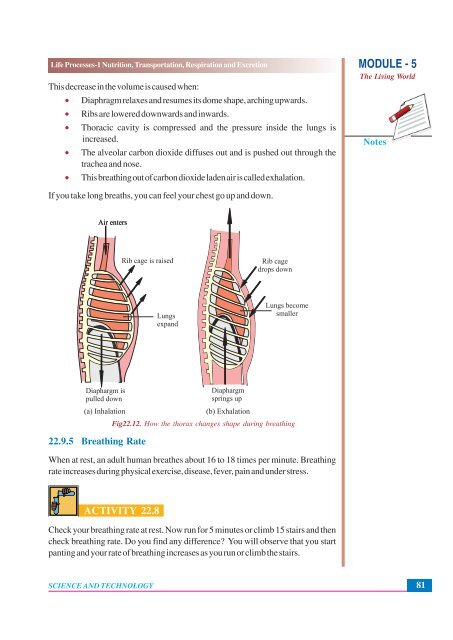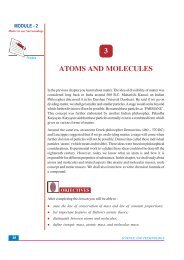Nutrition, Transportation, Respiration and Excretion
Nutrition, Transportation, Respiration and Excretion
Nutrition, Transportation, Respiration and Excretion
You also want an ePaper? Increase the reach of your titles
YUMPU automatically turns print PDFs into web optimized ePapers that Google loves.
Life Processes-1 <strong>Nutrition</strong>, <strong>Transportation</strong>, <strong>Respiration</strong> <strong>and</strong> <strong>Excretion</strong><br />
This decrease in the volume is caused when:<br />
• Diaphragm relaxes <strong>and</strong> resumes its dome shape, arching upwards.<br />
• Ribs are lowered downwards <strong>and</strong> inwards.<br />
• Thoracic cavity is compressed <strong>and</strong> the pressure inside the lungs is<br />
increased.<br />
• The alveolar carbon dioxide diffuses out <strong>and</strong> is pushed out through the<br />
trachea <strong>and</strong> nose.<br />
• This breathing out of carbon dioxide laden air is called exhalation.<br />
MODULE - 5<br />
The Living World<br />
Notes<br />
If you take long breaths, you can feel your chest go up <strong>and</strong> down.<br />
22.9.5 Breathing Rate<br />
Fig22.12. How the thorax changes shape during breathing<br />
When at rest, an adult human breathes about 16 to 18 times per minute. Breathing<br />
rate increases during physical exercise, disease, fever, pain <strong>and</strong> under stress.<br />
ACTIVITY 22.8<br />
Check your breathing rate at rest. Now run for 5 minutes or climb 15 stairs <strong>and</strong> then<br />
check breathing rate. Do you find any difference? You will observe that you start<br />
panting <strong>and</strong> your rate of breathing increases as you run or climb the stairs.<br />
SCIENCE AND TECHNOLOGY<br />
81
















